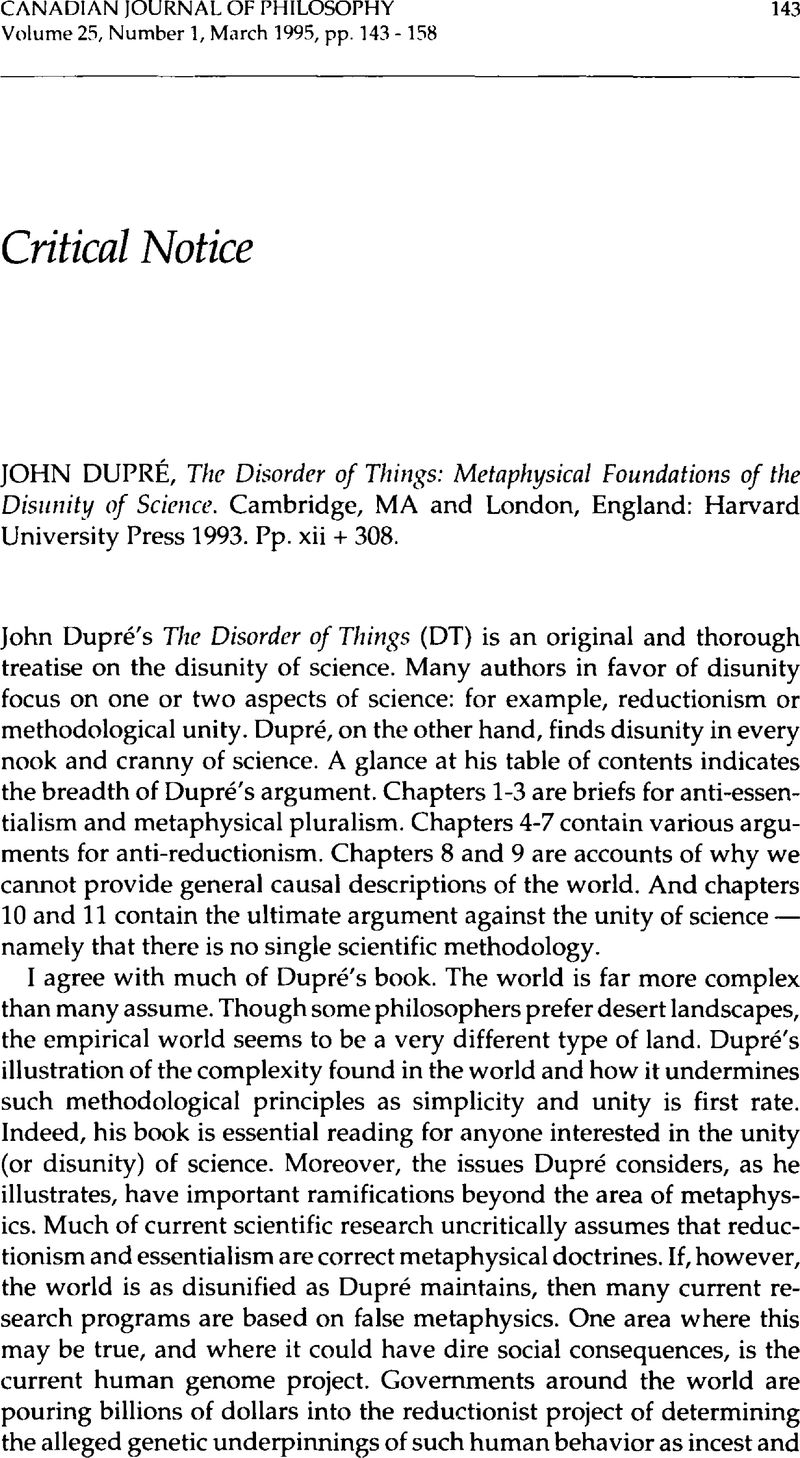Article contents
John Dupré, The Disorder of Things: Metaphysical Foundations of the Disunity of Science. Cambridge, MA and London, England: Harvard University Press 1993. Pp. xii + 308.
Review products
Published online by Cambridge University Press: 01 January 2020
Abstract

- Type
- Critical Notice
- Information
- Copyright
- Copyright © The Authors 1995
References
1 Lewontin, R. Biology as Ideology: The Doctrine of DNA (New York: Harper Collins 1992)Google Scholar
2 For example, Hull, D. ‘A Matter of Individuality,’ Philosophy of Science 45 (1978) 335–60CrossRefGoogle Scholar; Ghiselin, M. ‘A Radical Solution to the Species Problem,’ Systematic Zoology 23 (1974) 536–44CrossRefGoogle Scholar; and Sober, E. ‘Sets, Species, and Evolution: Comments on Philip Kitcher's “Species,“’ Philosophy of Science 51 (1984) 334–41.CrossRefGoogle Scholar
3 I have kept the argument here fairly simple. A further complexity is that the predators of an organism may belong to numerous species, and that organisms that share some of the same predators may not share all of the same predators. In other words, the relation between species that are prey and species that are predators is many to many. Dupré needs the relation to be one to one or at least one to many.
4 Hull, D. The Metaphysics of Evolution (Albany, NY: SUNY Press 1989), 225Google Scholar; Ereshefsky, M. The Units of Evolution: Essays on the Nature of Species (Cambridge, MA: Bradford Books/MIT Press 1992), 192Google Scholar
5 Hull, D. The Metaphysics of Evolution, 112Google Scholar; Ghiselin, M. ‘Individuality, History and Laws of Nature in Biology,’ in Ruse, M. ed., What the Philosophy of Biology Is: Essays Dedicated to David Hull (Dordrecht: Kluwer 1989), 58Google Scholar
6 ‘Sets, Species, and Evolution,’ 335
7 See my The Units of Evolution; Dupré lists four of those definitions (DT, 44-50).
8 For example, Hull, D. ‘Genealogical Actors in Ecological Roles,’ Biology and Philosophy 2 (1987) 168–83Google Scholar; and Ghiselin, M. ‘Species Concepts, Individuality, and Objectivity,’ Biology and Philosophy 2 (1987) 127–43.Google Scholar
9 See my ‘Eliminative Pluralism,’ Philosophy of Science 59 (1992) 671-90.
10 See, for example, Sober's ‘Sets, Species, and Evolution'; Hull's ‘Genealogical Actors in Ecological Roles'; and Ghiselin's ‘Species Concepts, Individuality, and Objectivity.'
11 Hull, D. ‘Genealogical Actors in Ecological Roles,’ 181Google Scholar; Ghiselin, M. The Triumph of the Darwinian Method (Berkeley, CA: University of California Press 1969), 79Google Scholar
12 Hull, D. The Metaphysics of Evolution, 120-1Google Scholar
13 Hull, D. ‘Genealogical Actors in Ecological Roles,’ 180Google Scholar; ‘A Function for Actual Examples in Philosophy of Science,’ 313; Ghiselin, M. ‘Species Concepts, Individuality, and Objectivity,’ 135–6Google Scholar
14 See, for example, Kitcher, P. Abusing Science: The Case Against Creationism (Cambridge, MA: MIT Press 1982), ch. 2Google Scholar; and Sober, E. Reconstructing the Past: Parsimony, Evolution, and Inference (Cambridge, MA: Bradford Books/MIT Press 1988), § 4.2.Google Scholar
15 See Cartwright, N. How the Laws of Physics Lie (New York: Oxford University Press 1983)CrossRefGoogle Scholar for examples from physics.
16 See Thagard, P. ‘Why Astrology is a Pseudoscience,’ in Asquith, P. and Hacking, I. eds., Proceedings of the Philosophy of Science Association, 1978 (East Lansing, MI: Philosophy of Science Association 1978) 223–34.Google Scholar
17 Dupré, however, may shy away from calling one ‘science’ and the other ‘nonscience' and instead prefer to say that one is a more superior project of inquiry than the other. If that is Dupré's response, then our dispute is merely terminological.
18 See, for example, Ghiselin's ‘Species Concepts, Individuality, and Objectivity.’
19 See, for example, Simpson, G. The Principles of Animal Taxonomy (New York: Columbia University Press 1961).CrossRefGoogle Scholar
20 Kuhn, T.S. The Essential Tension (Chicago: University of Chicago Press 1977)CrossRefGoogle Scholar
21 I thank Elliott Sober, Bob Ware, and Barrett Wolski for their comments on an earlier version of this essay.
22 Editor's Note: This critical notice was accepted for publication before Marc Ereshefsky became an Editor with the Canadian journal of Philosophy.
- 5
- Cited by


